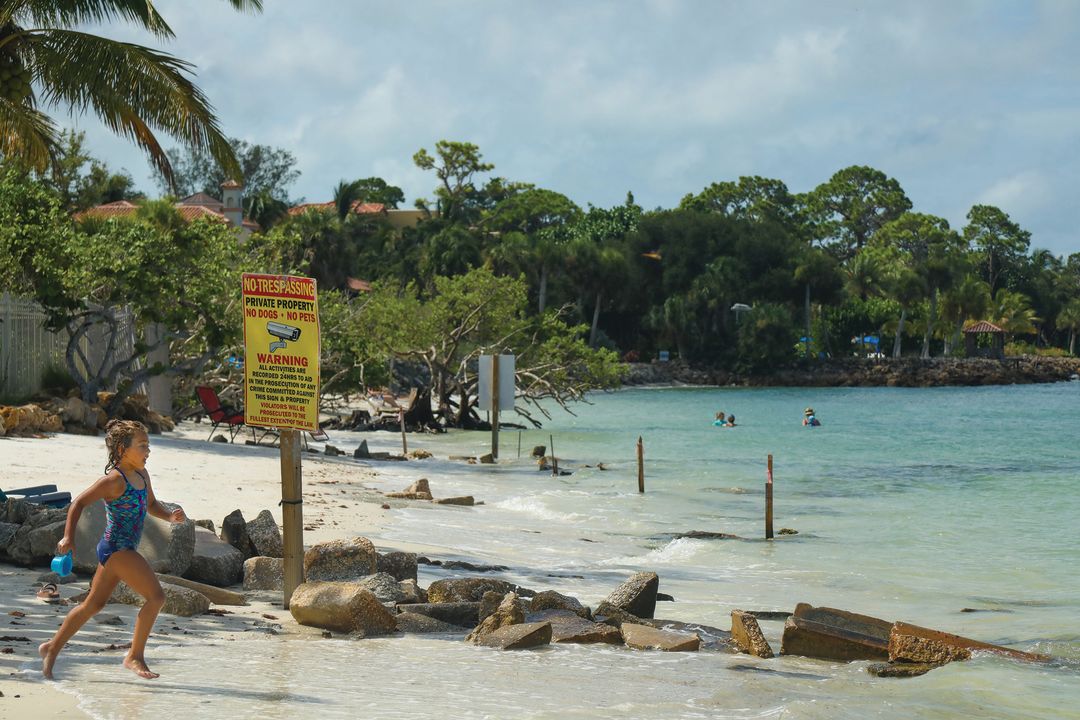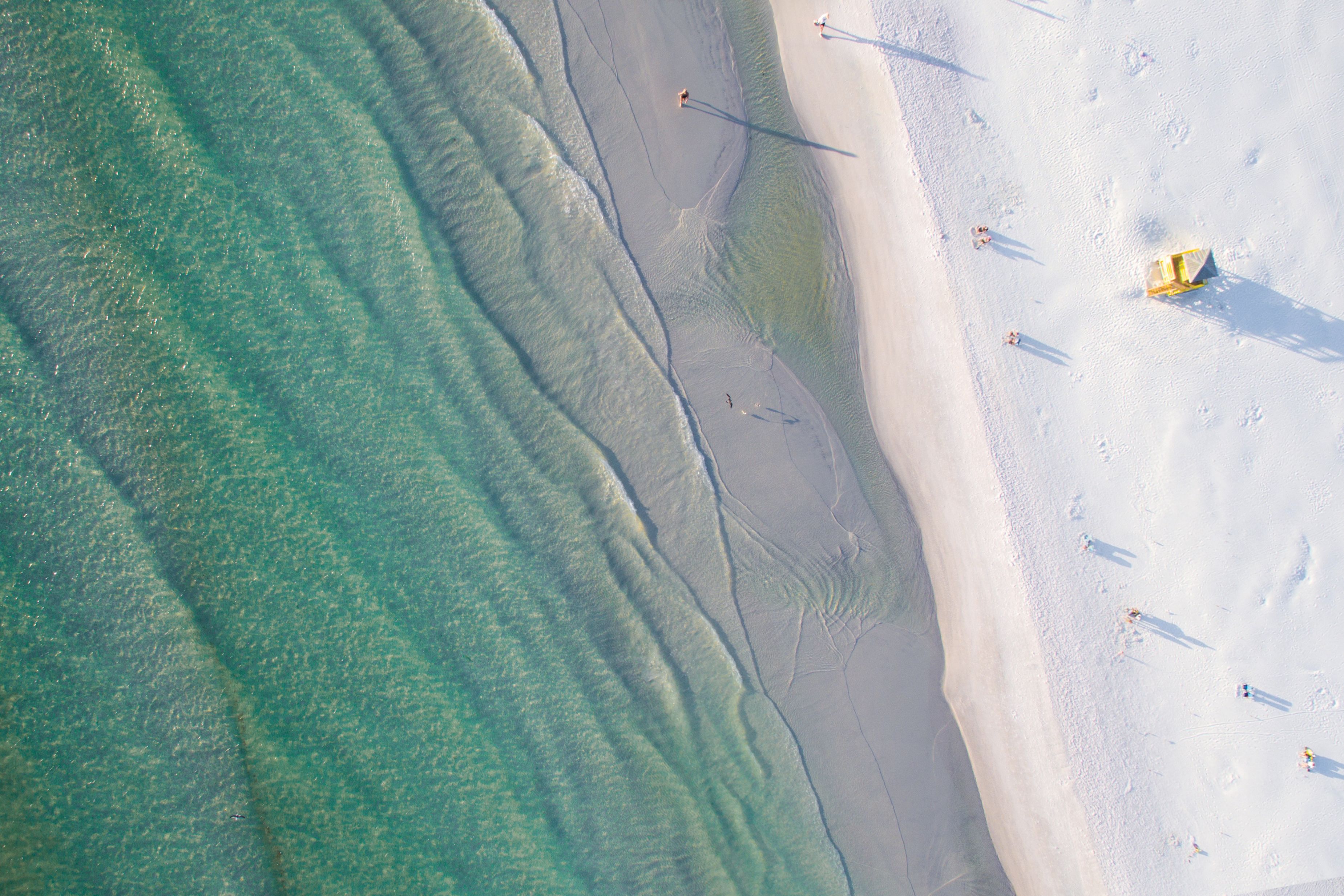Sarasota Just Lost Some More of Its Public Beaches

In this photo, taken last year, a little girl runs beside the “No Trespassing” sign on Shell Road Beach.
Image: Chad Spencer
Sarasota’s public beaches continue to disappear—not to rising sea levels, erosion or red tide, but to new laws that carve away beach access from the public. The latest legal maneuver is Sarasota County Commission Ordinance No. 2021-034, which passed unanimously and without fanfare just before noon on Sept. 28, 2021. It grants private property owners the ability to put up multiple "no trespassing" signs and 8-foot-high flags on the beach without a permit. Eighty percent of Sarasota’s coast is already private; this ordinance further whittles away what the public can enjoy.
While at first glance this might appear like an innocuous modification to existing beach property law, this alteration is just the latest in a series of changes in the state of Florida that further prevents public access and rights to our beaches.
The ordinance amends the regulatory language in the county's Unified Development Code (UDC) about incidental signs—that is, freestanding signs without footers or electrical components—placed on beachfront property. Before the change, the code allowed one incidental sign per property. Now, according to Planning and Development Services assistant director Michele Norton, “The new ordinance allows people to erect four incidental signs on their property without a permit. Residents can also erect one sign for every 500 feet of their property's perimeter.”
The ordinance also allows for a new “maximum aggregate square footage” for the signs, permitting a total of 24 square feet per residence. Additional square footage is allowed depending on the size of the property. It also grants owners the ability to place 8-foot-high flags along the border of the property.
As reported in our story "Who Owns Florida’s Beaches?," the state's beaches, including Sarasota’s, are being taken away from the public by laws that favor private property owners. Five years ago, Walton County, in the Florida Panhandle, fought against private property owners and private resorts wrongfully asserting their ownership of public dry sand by passing a local customary use law that granted the public access to historically used sandy beaches. In other words, if the public has been using a beach historically, private property owners could not prevent people from using it today. But in 2018, the Florida Legislature all but put an end to local governments implementing customary use law by passing HB 631, a law that created a complicated and expensive legal process that handed over beach to private property owners.
In Sarasota, Siesta Key Beach Access No. 1, also known as Shell Road Beach, has been ground zero in the fight for the public’s right to beach access. Police are called regularly to remove alleged trespassers from the beach, and several people have been arrested and await trial.
Sarasota County assistant public defender Aaron Getty, who is representing one of these alleged trespassers, believes that the new ordinance is misguided. “The public has expressed a legitimate concern that homeowners have been illegally placing signs on public property with the goal of excluding the public from the public beaches,” he told me. “It's disappointing that the people who were elected to serve the public have responded to this concern by adopting an ordinance which only makes it easier to exclude the public from areas in which they are constitutionally permitted to be.”
In attendance the morning of the county commission meeting were five private property owners supporting the ordinance and advocating for even more changes in order to keep the public off the beach.
When it was time for public presenters, Clayton Taylor was first up to the microphone. He said he represented a south Casey Key owners group, the North Casey Key Association and that he had support from the Casey Key Association. Taylor began by pointing to the American flag and said, “We all pledge allegiance to that flag for liberty, and in this UDC change, there is a restriction on free speech.” He was referring to the part of the ordinance that said temporary signs on the beach had to be removed from dusk until dawn.
“I think this is an intrusion into our First Amendment,” Taylor continued. “An unfair restriction to place upon us as landowners and citizens.” He pleaded with the commissioners to think about the poor, nesting animals that would benefit if the public were kept off the beach.
Another Casey Key homeowner, Christopher Tribelli, who just bought his beachfront home four months before the meeting, told the commissioners about issues he’s had with trespassers in the short time he has lived in Sarasota. “The amount of trespassing and lawlessness I’ve seen on my property is unbelievable,” Tribelli said. He added that he’s had to kick people off the chairs he’s set up on the beach. “I don’t know if they’ve been vaccinated for Covid. I’ve had to sanitize the chairs again.” (For more than a year now, studies have shown that it is highly unlikely that Covid-19 will transmit through surfaces.) “There’s a lot of public misinformation of who owns the beach,” he said. “It is our property.”
Misinformation and legal clarity are the major issues in any discussion over who owns the beach. The state of Florida uses two laws to delineate between public and private property. The first is the aforementioned customary use, which says that if the beach has historically been used by the public, then its use “should not be interfered with by the owner.” The second, and most widely used, is the Mean High Water Line (MHWL). This is the roughly 19-year average of high tides along set points on Florida’s coastline, which is used in state law to determine public beach. While both of these laws contribute to misunderstandings by the beach-going public and private beachfront property owners, the MHWL is the measurement that Sarasota County’s new ordinance uses to determine where private property owners can put their signs.
There are a host of problems using the MHWL to demarcate private property. One of the main issues is knowing precisely where this line exists at every point on the beach. Private property owners pay private surveyors to mark this line, but at high tide, the line is underwater, leading to conflicts with people who are trying to legally walk laterally along the coastline.
The other issue is the veracity of the line. This is one of the main issues at Shell Road, where several trespassing cases are awaiting trial. The line that the private property owners drew, and that local law enforcement defers to, is not necessarily accurate. A handful of local beachgoers at Shell Road paid for two separate surveys to be done earlier this year. At certain points, the new surveys showed that the stakes that local law enforcement used to determine private property were nearly 13 feet onto public beach, effectively stealing land from the public and wrongfully informing beachgoers that they were trespassers.
According to Alyson Flournoy, a former professor at the University of Florida who specializes in property, administrative and environmental law, “While private surveyors may determine the MHWL for landowners, it’s not an official determination.”
Attorney Getty says, “There is a legitimate concern that law enforcement will simply assume these signs accurately define property boundaries, regardless of their veracity. This will likely result in citizens getting arrested for trespassing when they are not.”
More likely is that people will stay off the beach for fear that they could get in legal trouble. “This ordinance certainly adds another layer of confusion to the already complex issue of who owns the beach,” Getty says. “Most people will not risk getting arrested if there is a sign telling them they are trespassing [even if they are not], so this ordinance will certainly have a chilling effect on citizens being able to enjoy all aspects of the public beach.”
I asked Norton, of Planning and Development Services, how the county will make sure that when these new signs go up, they are accurately positioned. If the signs are temporary and moveable, how can a private property owner be sure to put them in the right place every time? “Standard code enforcement process would be in place as for any sign," Norton told me.
But isn’t that the problem? The signs aren’t necessarily in the right place to begin with and, realistically, will someone from the county be there every morning to check their placement? At Shell Road Beach, for example, a property owner put up illegal barriers and signs. The public complained for years to the county that they were being wrongfully forced off the beach or arrested for trespassing before the county finally forced the property owner to remove the unlawfully placed signs and barriers.
The other issue with the MHWL is that the data currently being used to measure it is up to 40 years old. The current MHWL comes from an average of high tides between 1979-2000. The National Oceanic and Atmospheric Administration (NOAA), the organization that compiles this data, is currently compiling the years between 2000-2020, meaning that the current MHWL is outdated. Unfortunately, NOAA won’t have new averages available until 2025. Will private property owners be required to update their property lines then?
“It would be between the sheriff and the property owner as to whether they can demonstrate trespassing," Norton says.
At the meeting, no one was there to advocate on behalf of the public. I asked members of the public beach Facebook advocacy group Friends of Shell Road Beach whether they knew the meeting was taking place. No one I talked to said they were aware of it. And the timing was inconvenient, too. How many people can attend meetings when they begin at 10 a.m. in the morning and go on for hours? Most people are not able to take off work to advocate for their rights in the middle of the day during the middle of the week.
Sarasota County commissioner Nancy Detert voiced concern. “Call me old-fashioned, but I think that no individual owns the natural environment, and it’s here for everyone,” Detert said at the meeting.
I called her to ask why there weren’t any other public advocates there that day.
“I don’t think the public was aware of this,” she told me. “I’m just trying to quietly gather facts and not create any warfare.” She agreed that the MHWL is an issue. Even when she was in Tallahassee as a state senator and state representative, she said nobody could ever figure out where it was.
“I’m concerned that the public will lose their right to walk on the beach,” she says. “Anybody will [take advantage of this new ordinance], no matter what. We have so many people, especially on Casey Key, asking to extend their houses past the coastal setback line [the line beyond which you cannot build without government approval]. By doing that, they’re further pushing people out because they can say, ‘Look, my porch is right here. This is obviously my property.’ Well, it wasn’t originally. It shouldn’t be, in my estimation. Part of the beauty of the state of Florida is that you can walk the beach.”
I don’t blame the property owners for wanting the beach all to themselves. I hate sharing the beach with other people—especially when they are jerks. Who wants to listen to a bunch of people playing their crappy music too loudly, leaving trash and harassing wildlife? The public owes it to the beaches, the police, the owners, each other—not to be inconsiderate. We have to share this world with everybody, and the beach is a public right.
What became clear as the meeting went on is that there is an unfortunate antagonism and mistrust private property owners have toward the public. Laly Ballard, the last public speaker at the meeting, talked about needing multiple “lines of defense” from the public because she feared for her safety. Even though the Casey Key Association already hires private security guards to patrol the beach, she claimed adding ropes and more signs would assuage her fears.
Sarasota County Commission chairman Alan Maio was moved by Ballard’s fears. He said he was concerned “what our less-than-kind citizens are doing to our nicer citizens,” and said he would look into the possibility of changing the Gulf Beach setback line “because I think about my family and my three kids, five grandkids. We need to also maintain some sort of protection for folks.” Maio did not respond to requests for an interview.
Several of the people who are having issues with the public have recently purchased property in Florida. I couldn’t help but be amused by a point made by Ballard, who bought her home for just under $2.3 million a little over a year ago. She accidentally made the case for the customary use of the beach in front of her property. “They don’t know they are trespassing,” Ballard said, “because they have been walking the beach forever.”
What’s next? If the public wants to save Florida’s public beaches, it will have to organize and vote for elected officials who want to preserve this right. And if our elected officials want to keep Florida’s main tourist attraction and the billions of dollars beaches add to the economy annually, they should fight to keep as much of it public as possible. While there are statewide groups like Florida Beaches for All, they don’t handle local issues like the ones we are experiencing in Sarasota. In the meantime, there are a few people who are challenging Sarasota’s trespassing laws. Stay tuned for the trials.



